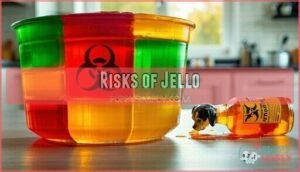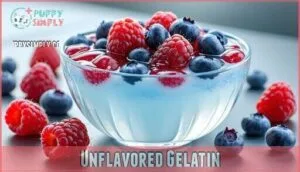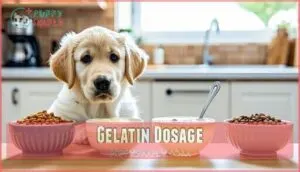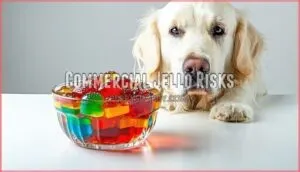This site is supported by our readers. We may earn a commission, at no cost to you, if you purchase through links.

A small amount of xylitol-free jello won’t kill your dog, but it’s not worth the risk. Instead, you can let dogs eat jello gelatin safely by choosing unflavored, plain gelatin powder mixed into their food.
This gives them the health benefits without the dangerous additives. Think of it like choosing between candy and vitamins – both might taste good, but only one actually helps.
There are simple ways to make gelatin treats that your dog will love.
Table Of Contents
Key Takeaways
- Don’t give your dog regular Jell-O – it contains high sugar levels and potentially toxic xylitol that can cause serious health problems or death
- Plain, unflavored gelatin is safe and beneficial – it supports joint health, skin, and digestion when given in proper amounts based on your dog’s weight
- Always read labels carefully – sugar-free versions are particularly dangerous since they often contain xylitol, which causes hypoglycemia and liver failure in dogs
- Make homemade gelatin treats instead – use unflavored gelatin powder mixed with dog-safe broth to get the health benefits without harmful additives
What is Jello
You’ve probably seen colorful, jiggly Jello in grocery stores and wondered if your dog can enjoy this sweet treat too.
Jello is a gelatin-based dessert made from powdered gelatin, sugar, artificial flavors, and food coloring that transforms from liquid to a wobbly solid when cooled, making it a unique and jiggly dessert.
Composition of Jello
Understanding jello ingredients dogs need to know starts with examining what’s inside that colorful, wobbly treat.
Jello contains powdered gelatin derived from animal collagen source, plus sugar content that can spike dangerously high.
Most varieties pack artificial sweeteners like xylitol in jello, which proves toxic to dogs.
Food coloring and artificial flavors complete this sugarfree jello dogs should avoid completely.
Types of Gelatin
Gelatin comes in several forms, each with different properties that affect your dog’s safety.
The main types include animal-based and plant-based options, with varying processing methods and sources.
Types of gelatin you’ll encounter:
- Beef Gelatin – Made from cow bones and skin, commonly found in brands like Great Lakes and Knox Gelatin
- Fish Gelatin Powder – Derived from fish skin and bones, often used in kosher products
- Gelatin Capsules – Typically made from beef or pork, used for supplements and medications
Most commercial jello uses Type A gelatin (acid-processed) or Type B (alkali-processed) from pig skin or cattle.
Knox Gelatin and Great Lakes represent popular unflavored options that work well for homemade dog treats when you want to avoid harmful additives.
Leaf gelatin is often preferred due to ease of measurement.
Nutritional Value
Nutritionally speaking, jello brings almost nothing to your dog’s table.
While gelatin itself contains protein content and amino acids like glycine and proline, commercial jello’s caloric density comes mainly from sugar.
There’s a complete vitamin absence in these products, and minimal mineral contribution.
The collagen-derived gelatin nutrition dogs could benefit from gets overshadowed by harmful additives, making jello nutrition dogs receive practically worthless for their health needs.
Can Dogs Eat Jello
The short answer is no – you shouldn’t give your dog regular Jello.
Regular Jello is off-limits for dogs due to dangerous sugar levels and toxic artificial sweeteners.
While dogs eat jello occasionally without immediate harm, commercial jello for dogs contains high sugar levels and artificial additives that pose health risks.
The main concern isn’t whether is jello safe in tiny amounts, but rather the cumulative effects of sugar and potentially toxic sweeteners like xylitol in jello.
Most store-bought varieties lack nutritional value and can contribute to obesity, diabetes, and dental problems.
Sugar-free options are particularly dangerous since they often contain xylitol, which is highly toxic to dogs.
Even small amounts can cause severe hypoglycemia. Toxic fruits are harmful, and should be avoided in your dog’s treats.
If you want to give your pet gelatin for dogs, focus on plain, unflavored alternatives.
Homemade recipes using pure gelatin provide the same satisfying texture without harmful additives.
Safe brands like Knox or Great Lakes offer unflavored options.
Always practice treat moderation and vet consult before introducing new foods to guarantee your dog’s safety and wellbeing.
Benefits of Gelatin
While plain Jell-O offers little nutritional value for dogs, the gelatin component provides several important health benefits when given in its pure form.
This natural protein supports your dog’s joints, skin, and digestive system in ways that can improve their overall quality of life.
Joint Health
The secret to your dog’s pain-free golden years might surprise you.
Gelatin benefits go beyond simple treats, offering powerful arthritis relief and cartilage support that can transform your furry friend’s mobility.
- Daily gelatin supplementation reduces joint pain while improving physical activity in dogs with arthritis
- Collagen synthesis doubles when gelatin is combined with exercise, accelerating injury recovery
- Inflammation reduction occurs naturally through gelatin’s unique amino acids like glycine and proline
This natural mobility improvement comes from gelatin’s ability to cushion joints and reduce stiffness, making those morning walks enjoyable again for your canine companion.
It’s also worth noting that gelatin is mostly composed of protein.
Skin and Fur
When you give your dog gelatin, you’re basically giving them a natural beauty treatment.
This powerhouse supplement boosts skin hydration by up to 28% and increases collagen density by over 10% after eight weeks.
Your dog’s coat health improves dramatically as amino acids stimulate hair follicles, resulting in thicker, shinier fur.
Gelatin benefits include enhanced wound healing and potential allergy relief through improved skin barrier function, providing a dramatic improvement in overall health.
Digestive Health
Beyond healthy coats, gelatin supports your dog’s digestive system.
The amino acids in gelatin help strengthen gut lining and improve nutrient absorption.
When dogs experience upset stomach or diarrhea, gelatin can provide relief by protecting the intestinal wall.
This makes digestion easier and supports overall dog health, addressing key dog dietary needs naturally, with gelatin providing benefits and supporting digestive system functions.
Risks of Jello
While commercial Jello might seem like a harmless treat, it poses several serious health risks for your dog.
The high sugar content, artificial sweeteners, and toxic ingredients like xylitol can cause everything from digestive upset to life-threatening emergencies, including serious health issues.
High Sugar Content
High sugar content in Jell-O can wreak havoc on your dog’s health.
Regular consumption leads to obesity risks, diabetes threat, and heart problems.
The concentrated sugar triggers pancreatitis risk and organ damage over time.
Even small amounts contribute to dog diabetes development and dog obesity. Skip the sugary treats—your pup’s pancreas will thank you later.
Artificial Sweeteners
Why worry about sugar when artificial sweeteners pose their own risks?
Sugar-free jello contains aspartame and sucralose, which can trigger digestive upset in dogs.
While these artificial sweeteners aren’t as dangerous as xylitol, they still cause vomiting, diarrhea, and lethargy.
Sorbitol creates laxative effects, leading to uncomfortable bloating and gas.
Even "natural" stevia can upset sensitive stomachs, making plain gelatin the safest choice.
Some jellies may also contain toxic fruits for dogs, posing a significant health risk.
Xylitol Toxicity
When checking sugar-free jello products, you’ll find xylitol lurking in many varieties—this artificial sweetener spells serious trouble for your dog.
Even tiny amounts can trigger life-threatening hypoglycemia within hours.
Even tiny amounts can trigger life-threatening hypoglycemia within hours.
Xylitol toxicity symptoms include:
- Vomiting and diarrhea – often the first warning signs
- Loss of coordination – your dog may stumble or seem dizzy
- Lethargy and weakness – sudden energy drops signal danger
- Seizures – requires immediate emergency treatment
- Collapse – can progress to coma without quick intervention
Always read jello labels carefully before sharing any treats with your pup.
Safe Gelatin Options
When you’re looking for safe gelatin options for your dog, stick to plain, unflavored varieties that don’t contain any artificial sweeteners or additives.
Pure beef gelatin, Knox unflavored gelatin, and Great Lakes gelatin are all excellent choices that provide joint and skin benefits without the risks found in commercial Jell-O products.
Plain Gelatin
Plain gelatin offers the purest form of gelatin for dogs, containing only animal-derived collagen without harmful additives.
This simple production process preserves essential amino acids that support your dog’s health. Unlike commercial jello, plain gelatin eliminates concerns about artificial sweeteners and dog allergies.
When choosing gelatin for dogs, verify it’s unflavored and sourced from reputable manufacturers. You can find chewy gelatin options online.
Is gelatin safe? Yes, when it’s plain and properly dosed for your pet’s size.
Unflavored Gelatin
Unflavored gelatin offers the purest form of collagen source for your dog’s health needs.
This processing method removes artificial flavors and colors while preserving essential amino profiles that support joint function and overall wellness.
When evaluating gelatin for dogs, look for products with transparent ingredient lists that avoid potential dog allergies triggers.
Consider these key factors when selecting unflavored gelatin:
- Gelatin Purity: Choose brands with 100% pure collagen content
- Collagen Source: Verify beef or fish-based origins for a desirable amino profile
- Processing Methods: Select cold-processed options that retain nutritional value
- Ingredient Transparency: Make certain no hidden additives that could trigger dog allergies
Is gelatin safe? Absolutely, when you choose unflavored varieties.
These gelatin ingredients dogs can safely consume provide the building blocks for healthy cartilage without unnecessary additives that commercial products often contain.
Consider chewy gelatin options for your dogs.
Beef Gelatin
Beef gelatin offers the highest quality collagen source for dogs, providing essential amino acids that support joint health and overall wellness.
You can safely incorporate beef gelatin into homemade recipes or mix it directly with your dog’s regular food.
Safe dosage depends on your dog’s weight, starting with small amounts to monitor tolerance, and this natural supplement delivers concentrated protein benefits without artificial additives found in commercial dog treats, making it a great option for overall wellness.
Gelatin Dosage
When you give your dog plain gelatin, the right amount depends on their weight to keep them safe and healthy.
Mix the powdered gelatin with warm water or broth before adding it to their food so it dissolves properly and doesn’t clump up, which is crucial for their safety.
Weight-Based Dosage
When calculating dog gelatin dosage, start with 1 teaspoon per 20 kg (44 lbs) of body weight daily.
You can gradually increase to 2-3 teaspoons as your dog tolerates it.
Smaller dogs under 10 kg need only ½ teaspoon twice daily, while larger dogs over 35 kg can handle up to 1 tablespoon twice daily.
Always consult your veterinarian for individual needs and avoid overfeeding risks, as this is crucial for your dog’s health and well-being.
Mixing With Food
When mixing gelatin with your dog’s food, you’ll want to dissolve the powder in warm broth or water first.
This prevents clumping and guarantees even distribution throughout kibble or wet food.
Simply sprinkle the dissolved mixture as a topper over regular dog food, or blend it into homemade dog treats for better palatability and nutrition.
Homemade Gelatin Treats
Making your own gelatin treats gives you complete control over what your dog eats while avoiding harmful additives found in commercial jello.
You can create healthy, tail-wagging snacks using simple ingredients like plain gelatin, dog-safe broths, and natural flavors that support your pup’s joint health.
Recipes and Ingredients
Making homemade dog treats opens up a world of safe, nutritious options for your furry friend.
Simple recipes using plain gelatin create delicious alternatives to commercial products filled with harmful additives.
Here are five dog-friendly gelatin treat recipes:
- Beef Broth Jello – Mix unflavored gelatin with low-sodium beef broth for protein-rich treats
- Fruit Puree Jello – Blend dog-safe fruits like blueberries with plain gelatin for antioxidant benefits
- Veggie Gelatin Bites – Combine pureed carrots or sweet potatoes with gelatin for vitamin-packed snacks
- Bone Broth Gelatin – Use homemade bone broth as your liquid base for maximum nutrition
- Agar-Agar Substitute – Replace gelatin with this plant-based alternative for sensitive dogs
These homemade dog jello recipes avoid artificial sweeteners, colors, and preservatives found in store-bought versions, ensuring your pet enjoys unsweetened jello dogs can safely consume.
Consider low calorie ingredients like pumpkin to further enhance the nutritional value.
Storage and Handling
Store your homemade dog jello in the refrigerator for up to five days maximum.
Refrigeration Needs are essential for pet safety – room temperature storage creates Contamination Risks within hours.
Consider proper chewy storage to maintain treat quality.
For Safe Thawing, move frozen treats to the fridge overnight rather than countertops.
Preparation Time should include cooling periods, and always check for spoilage before serving your dog treats.
Variations and Alternatives
You can create exciting variations of homemade gelatin treats that go beyond basic recipes.
Try these creative alternatives for your dog:
- Agar-Agar – Plant-based vegan jello that’s completely safe
- Bone Broth gelatin – Rich in nutrients and flavor
- Pectin Options – Natural fruit-based thickeners
- Fruit Purees – Blended with plain gelatin for taste
- Frozen treats – Pour into ice cube trays for summer snacks
These dog dietary alternatives offer safe dog treats without commercial risks.
Commercial Jello Risks
While store-bought jello might seem like a harmless treat, it contains ingredients that can seriously harm your dog’s health.
Commercial jello products are packed with artificial additives, preservatives, and sweeteners that weren’t designed for canine consumption.
Artificial Colors and Flavors
Commercial jello contains artificial colors and flavors that aren’t tested for canine safety.
These additives can trigger allergic reactions, digestive issues, and hyperactivity in sensitive dogs.
The bright colors you see aren’t natural – they’re synthetic dyes that may cause dog allergies over time.
Artificial sweeteners dogs consume through flavored jello create additional jello toxicity dogs face.
These substances offer no nutritional value while increasing canine safety risks and potential long-term effects on your pet’s health.
Preservatives and Additives
Preservatives lurking in commercial jello can wreak havoc on your dog’s digestive system.
These chemical additives often trigger gastrointestinal upset and food intolerance symptoms in sensitive pets.
Long-term effects from artificial sweeteners dogs consume may include chronic digestive irritants and allergic reactions.
Xylitol in jello poses severe toxicity risks, while other artificial colors create additional flavor concerns for your pup’s health, including potential gastrointestinal upset.
Choking Hazards
Jello’s slippery texture creates serious choking risks for your furry friend. Size matters regarding swallowing safety, and certain breeds face higher dangers than others.
- Size Matters – Small dogs can’t handle large jello pieces as easily as bigger breeds
- Breed Predisposition – Flat-faced dogs like pugs struggle more with slippery textures
- Greedy Eaters – Fast-eating dogs often gulp without chewing properly
- Texture Concerns – Jello’s smooth surface makes it slip down throats quickly
Supervision needed whenever dogs encounter gelatin-based treats to prevent emergencies. Its high sugar content poses health risks too.
Gelatin and Canine Health
While commercial Jello poses risks to dogs, plain gelatin offers several health benefits when given properly.
The amino acids in gelatin support your dog’s joint health, brain function, and help their digestive system absorb nutrients more effectively, which can be considered a key aspect of joint health.
Arthritis Prevention
Early supplementation with gelatin helps prevent arthritis in dogs of all ages.
Heavier breeds with genetic predisposition benefit most from joint health support. Weight management combined with gelatin reduces exercise impact on developing joints.
Regular gelatin intake strengthens cartilage before arthritis symptoms appear.
This natural alternative therapy supports long-term mobility and comfort for your dog.
Brain Health
Your dog’s brain health gets a boost from gelatin’s glycine content, which may help resist seizures and protect against brain damage.
This amino acid supports cognitive function in aging dogs and could reduce seizure frequency in the estimated 1% of dogs with epilepsy.
Regular gelatin supplementation provides neuroprotective effects through its unique amino acid profile.
Nutrient Absorption
Regularly supplementing your dog’s diet with gelatin substantially enhances nutrient absorption through improved gut lining health.
The amino acids in gelatin strengthen intestinal walls, boosting enzyme activity and protein digestion while supporting better mineral uptake.
Here’s how gelatin improves your dog’s nutrition:
- Gut lining protection – Collagen peptides form a protective barrier that prevents nutrient loss
- Enhanced enzyme activity – Amino acids support digestive enzymes for better protein breakdown
- Improved mineral uptake – Stronger intestinal walls absorb vitamins and minerals more effectively
Feeding Dogs Gelatin
When feeding your dog gelatin, you’ll want to consult your veterinarian first, especially if your pet has existing health conditions or takes medications.
Start with small amounts and watch for any digestive upset or allergic reactions, adjusting the dosage based on your dog’s response and overall health.
Consultation With Veterinarian
Before making dietary changes like adding gelatin to your dog’s routine, you’ll want veterinary advice to confirm it’s safe.
Your vet can assess breed predispositions, allergy concerns, and provide dosage approval based on your dog’s specific needs.
They’ll also establish health monitoring protocols to track any reactions and adjust recommendations accordingly for ideal dog safety.
Monitoring Health Effects
After your vet gives the green light, watch your dog closely for any reactions to gelatin. Most dogs handle it well, but some may show signs that need attention.
- Allergic Reactions: Watch for itching, swelling, or hives after feeding gelatin
- Digestive Upset: Monitor for vomiting, diarrhea, or stomach discomfort within hours
- Behavioral Changes: Notice if your dog seems restless, lethargic, or acts differently
- Long-Term Effects: Schedule regular veterinary checkups to track joint health improvements
Frequently Asked Questions (FAQs)
Can dogs eat Jello?
You shouldn’t give your dog regular Jell-O because it’s loaded with sugar and artificial sweeteners like xylitol, which can be toxic. Plain, unflavored gelatin is safe and beneficial for joints.
Can dogs eat sugar free Jello?
No, you shouldn’t give your dog sugar-free Jello. It often contains xylitol, an artificial sweetener that’s extremely toxic to dogs and can cause seizures, liver failure, or death.
Can dogs eat salmon Jello?
Nearly 90% of commercial Jello contains artificial sweeteners or high sugar content that’s harmful to dogs.
You shouldn’t feed salmon Jello to your dog since it likely contains xylitol, artificial flavors, and excess sugars that can cause serious health issues.
Can dogs eat gelatin?
Yes, dogs can safely eat plain, unflavored gelatin in moderation.
It’s actually beneficial for joint health, skin, and digestion.
However, avoid flavored Jell-O products containing sugar, artificial sweeteners, or xylitol, which are harmful to dogs.
What happens if a dog eats too much Jell-O?
When your dog eats too much Jell-O, they’ll likely experience stomach upset, diarrhea, and vomiting from the high sugar content.
The artificial sweeteners can cause dangerous blood sugar drops, requiring immediate veterinary attention.
Are gelatin capsules safe for dogs?
Gelatin capsules are generally safe for dogs since they’re made from digestible animal collagen.
However, you should consult your vet before giving them, especially if you’re unsure about the capsule’s contents or medications inside.
Can dogs have jello gelatin?
While you might worry about sharing your favorite dessert, plain gelatin is actually beneficial for dogs when given properly.
However, commercial Jell-O contains harmful sugars and potentially toxic xylitol.
Stick to unflavored gelatin instead.
What gelatine is safe for dogs?
Plain, unflavored gelatin from reputable brands like Great Lakes or Knox is safe for dogs.
You’ll want to avoid commercial Jell-O with artificial sweeteners, especially xylitol, which can be toxic to your furry friend.
How much gelatin per day for a dog?
Like a compass guiding navigation, dosage depends on your pup’s weight.
Give 1/2 teaspoon for 10-25 pounds, 1 teaspoon for 25-50 pounds, 2 teaspoons for 50-75 pounds, or 1 tablespoon for dogs weighing 75-100+ pounds daily.
Can puppies eat gelatin safely?
Yes, puppies can safely eat plain, unflavored gelatin in small amounts. Start with tiny portions and consult your vet first, especially for very young puppies under 12 weeks old.
Conclusion
Like a careful chef choosing ingredients for a special meal, you must be selective about what gelatin products you offer your dog.
While dogs can eat jello gelatin safely, stick to plain, unflavored varieties without sugar or artificial sweeteners.
Commercial jello contains dangerous additives like xylitol that can harm your pet.
Choose unflavored gelatin powder mixed into their regular food instead, as this approach gives your dog the joint and coat benefits of gelatin without the risks.
Always consult your veterinarian before adding new supplements to your dog’s diet.
- https://www.tryoriginlabs.com/blogs/pet/can-dogs-eat-jello-a-vet-weighs-in
- https://a-z-animals.com/blog/can-dogs-eat-jell-o-is-it-safe-or-dangerous/
- https://spoiledhounds.com/can-dogs-eat-jello-gelatin/
- https://www.fnp-gelatin.com/news/gelatin-for-dogs--everything-you-need-to-know.html
- https://customcollagen.com/how-gelatin-for-dogs-is-improving-pet-food-quality/



















